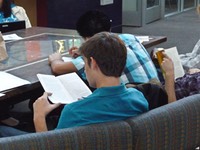The September, 2012 issue of Educational Leadership had some excellent articles about feedback for learning (the theme of the issue). One article that struck a special chord with me is a short two-page essay by Carol Ann Tomlinson (the same Carol Ann Tomlinson who is the differentiation guru!)[i]. Because of its location (towards the back of the issue) and size, you might have missed it!
Two aspects of this article are extremely powerful. One is how the author took her failure to improve student writing to heart and, as a result, developed a powerful set of student feedback and improvement principles and practices. The second important result is the development of a concept called “teacher learning moments” -- i.e. the ability of a teacher to take a negative teaching experience and use it as a catalyst to develop improved instructional approaches. Let’s look at these one at a time.
Improving student learning through feedback
In the article, Dr. Tomlinson (from now on called Dr. T) recalls a student in one of her English classes, Heather, who was a good writer. Dr. T. worked hard to provide her with helpful feedback and praise that would make her an even better writer, and thought she was really helping her to improve her writing. But, after Heather had graduated and gone on to college, Dr. T. met her mother in a local store and asked her whether Heather was doing writing in college that she enjoyed. In response, her mother said “Last week she (Heather) told me that for the first time in her life she was learning to become a better writer”.
This comment was “a punch in the stomach” to Dr. T., but she used this negative experience to try to figure out why Heather (and probably the other students in the class) didn’t feel that her writing had improved. Dr. T. realized that she had praised what Heather had written, but she “had no mechanism for helping her get better”.
Due to this insight, Dr. T. spent some time rethinking her teaching of writing. A few years later, in an “advanced seminar on education issues” college level course, she implemented the following five feedback principles to improve the writing abilities of her students:[ii]
Develop and share core target goals. The first step in improving learning is to develop a clear focus, a clear target for improvement, and to share that target with students. What is it that you really want your students to improve? What is your focus? Without a clear target, how can you know if you are helping your students improve? Unfortunately, many teachers often do not have a focused, targeted goal for improvement. And often, even when there is clarity, it is not shared with students. Thus, Dr. T. made it a point to explain to her college students that her target was to help them develop their power as writers and thinkers.
Clarify and share the key elements of excellence for the targeted goals, along with progressions for growth for each element. In order to “turn good writers into stellar ones – and adequate writers into good ones”, Dr. T. had to determine what poor, good and excellent writing look like. What are the characteristics of each? And how do you create a road map leading from poor to good and good to excellent writing? Dr. T. shared the key elements of writing excellence with students in a rubric format, along with a progression of growth for each criterion.
Give precise feedback and suggest specific ways for students to improve their work. Two key words here are “precise” and “specific”. Given the current level of student work, what precise feedback and specific suggestions for next steps will help students make improvements? The clarity of good writing elements and the development of a writing improvement process helped to transform her formerly vague and general feedback into useful, precise feedback and specific, helpful suggestions. Thus, Dr. T. gave her students precise and specific feedback on the results of their writing assignments.
Ask students to consider which components of your feedback are useful and which are not, and why, and ask them to develop plans for improvement. After receiving precise feedback, students wrote notes to Dr. T. indicating “which elements of the feedback seemed useful to them and which elements seemed off target”. They also wrote a brief plan for how they would use the helpful feedback to improve their writing. When there were misunderstandings in interpreting her feedback, Dr. T. met with the student briefly after class. This changed the improvement process from one that was being done to students to one that was being done with students! It also “customized” (differentiated) the learning process so that students developed their own unique plan and “owned” the result. And, finally, it gave her students a chance to learn how to analyze their own writing strengths and weaknesses, increasing the possibility of significant long-term results.
Don’t grade students through the improvement process! Dr. T. realized that her early grading of writing got in the way of student improvement. As she puts it: “…many [students] were so focused on getting the right answer that actual learning was a sidebar”. So she decided not to grade any writing until near the end of the semester! The upshot was that, during the early part of the semester, the students developed a true learning community that helped them all improve their writing.
----------------------
After reflecting on Dr. T’s principles for improving student learning, I realized how often, as a social studies middle and high school teacher, I violated and ignored these principles and practices. Sometimes I taught without having a clear, focused, targeted improvement goal, thereby making it virtually impossible for my students to improve their learning. Sometimes I was clear about my improvement goals, but spent little time clarifying the elements of excellence and providing precise feedback. Only rarely was I clear about a targeted improvement goal (such as helping my students categorize and create generalizations from historical knowledge), and then shared the elements of excellence, provided precise feedback, and visibly improved my students’ learning.
I also realized that these five principles, taken together, create a powerful process that all teachers can use to improve student learning for many different learning targets – for example, research skills, science investigation, long term projects, problem solving skills, critical or creative thinking, information literacy, reading for understanding, and other major goals teachers may want to work on with their students. The five principles can be adapted to all grade levels and all subjects.
Teacher Learning Moments
While a major result of Dr. T.’s analysis of her teaching is the five principles of feedback, another important insight she also offers us is her basic attitude towards failure and improvement. We know that all teachers make mistakes, have problems with classroom teaching and individual students, and need support and help. But one major difference among teachers is how they deal with these challenges. Instead of using mistakes, errors, and failures to improve teaching, too many hide instructional problems behind the closed door of the classroom. Many teachers are ashamed of their weaknesses. Some schools and districts understand that evaluations create opportunities for feedback, improvement, and new learning, but, in many cases, teaching problems are equated with failure, and the typical teacher evaluation process often deals with problems and mistakes through a negative judgment lens, rather than treating them as learning moments. This ultimately reinforces the desire to hide mistakes, failures, and problems, so that little or no progress is made in rectifying the situation!
As a profession, we need to take Dr. T.’s personal attitude towards improving her teaching to heart. Simply put, teaching problems, failures, and mistakes should be continually used to improve and refine teaching! In fact, the five feedback principles cited above can also be used to improve teaching experiences. Let’s use “teacher learning moments”, garnered through teacher self-evaluations and teacher observations, to set teacher growth targets, clarify what excellence and progress means, observe and give specific, precise feedback, and ask teachers to evaluate feedback and develop plans for change. Let’s develop non-threatening, non-judgmental environments so that teachers can work on improving their craft in a comfortable environment. This too is an important lesson we can learn from Dr. T.’s experience.
------------------
Learning occurs in many ways, and we can’t, nor should we, always target the exact learning that will occur with our students. But one aspect of our teaching responsibility is to be clear about those things that we think are important for our students to learn and improve. Once we clarify core learning targets, how do we insure that our students improve their learning in these areas? The principles and practices described by Dr. T. provide us with an explicit process for improving targeted student learning. And they are also invaluable in helping teachers grow and become more competent over time. These insights make me wish that I were back in the classroom again, so I could use these principles to target student growth in key areas and analyze my own teacher learning moments so as to dramatically improve my own teaching!
Endnotes
[i] For more details and greater insight into both improvement principles and teacher learning moments, read Carol Ann Tomlinson’s short but powerful article in the September, 2012 issue of Educational Leadership, What Heather Taught Me, pp. 88-89.
http://www.ascd.org/publications/educational-leadership/sept12/vol70/num01/What-Heather-Taught-Me.aspx
[ii] These five principles have been somewhat interpreted and adapted by the blog author, but the author has attempted to remain true to the essential features of the five principles developed by Dr. T.
Some Additional Resources on This Topic
Colvin, Geoff (2008). Talent is Overrated: What Really Separates World-Class Performers from Everybody Else. New York: Penguin Group. Especially the chapters on deliberate practice and their application.
Paul Tough (2012). How Children Succeed: Grit, Curiosity, and the Hidden Power of Character. New York: Houghton Mifflin Harcourt Publishers. Especially Chapter 3, How to Think.

